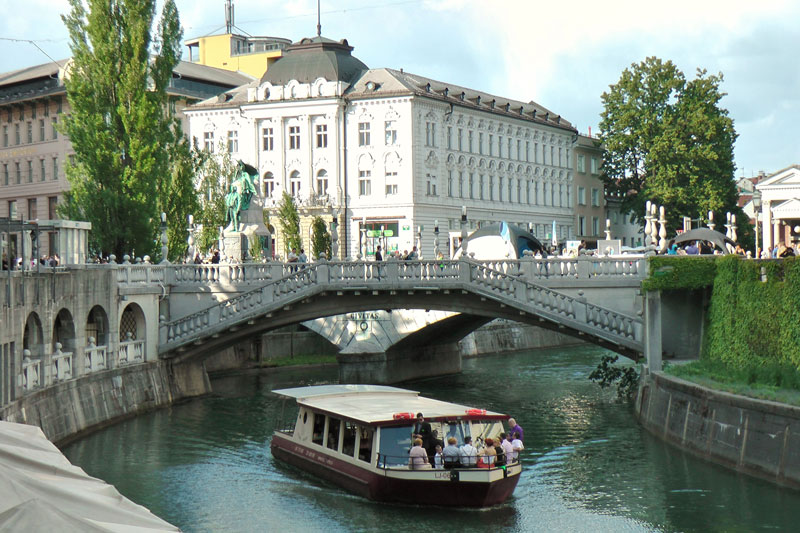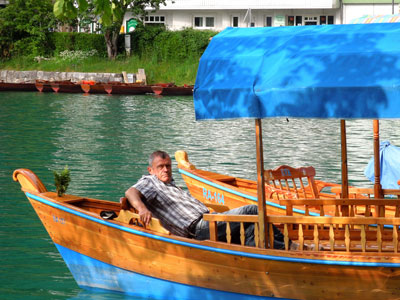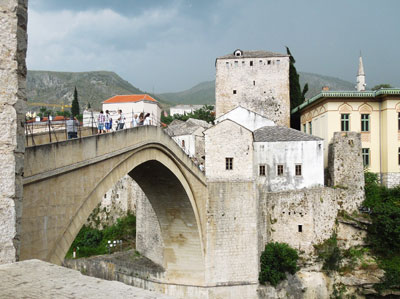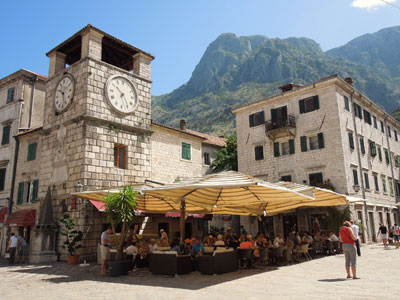Mountains, a monastery and reminders of war – a self-drive tour of the Balkans continues
This article appears on page 18 of the September 2015 issue.
During our June 2014 self-drive tour of the Balkans, my husband, Frank, and I used Croatia as a base (see Aug. ’15, pg. 30), making side trips to tour the surrounding countries that comprised the former Yugoslavia. Our first 4-day excursion took us from Zagreb to Slovenia.
Starting in Slovenia
Home to the Julian Alps and a portion of the Pannonian Plain and bordering the countries of Italy, Austria, Hungary and Croatia as well as the Adriatic Sea, Slovenia has Eastern European charm and a Western European mind-set.
Ljubljana, the country’s capital, is a 5-hour drive from Zagreb. The hardest part of the journey was finding a place to park once we arrived in the city, as its Saturday market was still underway. We finally parked and walked just five minutes to our accommodations, the Kollmann Apartments (Cankarjevo nabrežje 27; phone +386 51 268 288, ljubljana-
apartments.eu).
This old, traditional townhouse features apartments on the two upper floors and a hostel on the first floor. We had a very basic room upstairs (Room No. 3, €86, or $94, per night) with a small kitchenette that overlooked the Ljubljanica river.
The location of our apartment, between the Triple Bridge and Cobblers’ Bridge, couldn’t have been better. The Triple Bridge (Tromostovje), designed by Slovenian architect Jože Plecˇnik, is the heart of the city. The night view with all three bridges lit up was spectacular.
The tourist information center was located just a few steps away from the bridge and was a good resource for maps and city information.
We discovered a great restaurant, Paninoteka (Jurcˇicˇev trg 3), on a square across the river from our apartment, and having breakfast there became our morning ritual.
On our second day in Ljubljana we joined a free 2½-hour walking tour, which began at 11 a.m. Our guide, Janas (or John), was a former university professor who was very knowledgeable.
We covered the history of the city and its squares, which go back to the first century BC. Once a Roman town, it became part of Yugoslavia after WWII, and in 1991 Slovenia declared its independence.
Very modern and upscale, Ljubljana definitely had a Western European feel. Despite the numerous tourist boats going down the river, the city, with its many bridges and pedestrian-only streets in the Old Town, has incredible charm.
Castle to cave
The next day we took the funicular up to the castle and did the tour, which included the history museum and the viewing tower. During the one-hour tour (€12, or $13, per adult, including the funicular), actors, dressed to reflect the various periods of the castle’s 500-year-long history, told stories of specific periods at various stations. It was very well done.
The walk down the hill and back into the city took only 15 minutes.
On Sundays in Ljubljana, there is a flea market along the river with vendors selling their goods. I was delighted to find several interesting craftsmen (jewelry and scarves) there.
After breakfast at Paninoteka the next day, we drove out of town to Lake Bled, a lovely lake with an island church, reached by gondola. A castle, now a museum, is perched on the hill overlooking the lake.
The setting was very picturesque but felt a bit touristy, so we continued on another 20 kilometers to Lake Bohinj. This lake is larger than Lake Bled and was much less developed.
There was a hiking trail along the lake’s northern edge, and it took approximately 1½ hours to reach the other end of the lake.
Slovenia has two noteworthy caves: the popular Postojna Cave
and the Škocjan Caves complex. As we had time to explore only one of them, we chose the Škocjan Caves because of its designation as a UNESCO World Heritage Site.
Leaving Ljubljana, we took the A1 toward Koper to the Škocjan Caves, located near Divacˇa in the Karst region. We arrived in time for the noon walking tour, which lasted about an hour and a half and covered 2 kilometers through the cave. The huge cave was impressive.
Slovenia, with its diversity of mountains, lakes, caves and charming capital, was definitely worth the visit.
Bosnia & Herzegovina
From Split, Croatia (though this could be an easy excursion from Dubrovnik as well), we took the scenic road south along the Adriatic. There were a few very pretty towns sitting on the hillsides or jutting out into the sea along our route — a classic Croatian picture, indeed. Omiš, about 30 minutes outside of Split, was especially lovely.
It took us three hours to reach Mostar, Bosnia. (There was no problem crossing the border into Bosnia.)
Mostar is famous for its Stari Most, an arched stone bridge that stretches over the Neretva River. Completed in 1566, the bridge was recognized as one of the world’s major engineering accomplishments and stood for over 400 years, surviving WWII only to be destroyed in 1993 during the Bosnian War. The reconstructed bridge was completed in 2004 and is a UNESCO site.
The town, although a bit touristy, was picturesque, with narrow, meandering streets along the hills.
Sarajevo
We followed the river toward Sarajevo. On each side were tall, beautiful mountains, steeper than those we had seen in Croatia. Less English was spoken there, and signs were written in Cyrillic as well as English.
The GPS and directions downloaded from Google Maps got us to Hotel Old Town (C´urcˇiluk Mali 11A; hoteloldtown.ba) with absolutely no problem. We arrived in the early evening, around 6:30, so we had spent a good part of the day driving.
We had a very nice, large room (€89 per night) in Sarajevo’s Old Town, just two blocks from the main mosque and a block from the river and the site where Archduke Franz Ferdinand of Austria and his wife, Sophie, were assassinated in 1914.
Looking out our window at the building across the street, I saw unusual indentations in the wall. Instinctively, I knew they were bullet holes, but it was hard to believe that after 20 years the wall had not been plastered over. I later learned I was correct, and they were only the first of many bullet holes we would see in the city.
We had dinner at Restoran Pod Lipom (Prote Bakovicˇa broj 4; www.podlipom.ba) based on a recommendation from our hotel. A dish of local selections of grilled meats and Greek salad cost BAM25 ($14).
The next morning, after our included buffet breakfast, we walked to an information kiosk and discovered there was a tour of the Tunnel of Hope leaving immediately. We joined the tour (there were only three of us), and the group drove out of the city past the airport.
The tunnel was excavated underneath the airport to allow supplies to be brought into the city during the siege of Sarajevo, from 1992 to 1996. The tunnel is 1 meter wide, 1½ meters high and 800 meters long. It was built in six months using only hand tools, and it served as the only reliable means for receiving food, water, gas and ammunition.
The tunnel was also an escape route for those residents who could secure the necessary documentation and connections to leave. Our guide said his aunt and uncle had escaped Sarajevo through the tunnel, and it had taken approximately a year to arrange all the political connections.
The Tunnel of Hope Museum in the village of Donji Kotorac included an interesting documentary movie about the building of the tunnel and the bombing of the city. It is a “must see” if you go to Sarajevo.
More city sights
Sarajevo was established in the 15th century by the Ottoman Empire, and, today, the Turkish Quarter, with its pedestrian lanes, jewelry shops, copper workshops, clock tower, numerous cafés and mosques, reflects this influence.
The Austro-Hungarians arrived much later, in the late 1800s, and established Ferhadija Street as the main thoroughfare. There is an interesting architectural contrast there and a real demarcation of where East meets West.
In the late afternoon we joined a free tour that covered the Austro-Hungarian part of the city. The guide was a young law student born in the city during the siege.
We stopped at several of the historic buildings, including the old Sephardic synagogue, which dates from 1581 and now houses a Jewish museum. In the early 1500s, when Jews were expelled from Spain, the Sultan of the Ottoman Empire offered them a place to live, establishing a large Jewish population in Sarajevo until World War II.
We also visited the city’s beautiful Orthodox church, which had just been restored.
Scars of war
Throughout the city we came across “Sarajevo roses.” Each rose marks the spot where a mortar shell exploded, leaving a hole in the sidewalk that has now been filled with a red resin to resemble splattered blood. They serve as reminders of those killed during the siege.
We ended the tour at the Memorial to Children Killed During the Siege of Sarajevo, which honors the 1,600 children killed during the war.
The next morning we crossed the Miljacka River to explore the southern bank. We found the
Ashkenazi Synagogue, which is open in the mornings. Built in 1902 in a neo-Moorish style, it was quite impressive and is the only operating synagogue in Sarajevo today.
We then walked up the hill to the brewery, which, during the siege, provided the only reliable source of water for citizens until the tunnel was completed. You can still see the numerous bullet holes in the walls of the surrounding buildings and houses.
Our route back into the city passed the renovated Moorish-style City Hall, which was to be opened later that month as part of the commemoration of the 100-year anniversary of the beginning of World War I.
Unfortunately, the political situation in Bosnia & Herzegovina is complex. As we drove into the country from Croatia, it was apparent that it has a lot of catching up to do to be economically on a par with the other former Yugoslavian countries.
I vividly recall watching the XIV Winter Olympics, held in Sarajevo in 1984, and seeing how beautiful the city was, the fresh snow covering “pigeon square” with its ornate drinking fountain in the old Turkish Quarter. Although I thoroughly enjoyed Sarajevo and would definitely go back, I was saddened to see that the city has not yet returned to the splendor it had 30 years ago.
If you visit Sarajevo, I highly recommend two books that capture the impact of the Bosnian war on the residents of Sarajevo. The first is “The Cellist of Sarajevo” by Steven Galloway, a novel that follows a cellist who plays for 22 days, each day at the same time and place, to honor 22 civilians who were killed in the marketplace while waiting for bread.
The other book, “Logavina Street: Life and Death in a Sarajevo Neighborhood,” was written by Barbara Demick, a journalist who tells the story of the Bosnian War through the lives of ordinary citizens who lived in Sarajevo.
A week in Montenegro
If you are in Dubrovnik, Croatia, a side trip to Montenegro, even if it is only for a day, is well worth it. The Montenegro border is only about an hour south of the city, and crossing the border is straightforward. If you do not have a Green Card for car insurance, you can purchase one for €15 at the border.
The first town we encountered in Montenegro was Herceg Novi, which we drove through without stopping, as nothing caught our eye. There is a ferry from there to Kotor, but we chose to drive the 40 kilometers around the Bay of Kotor instead.
We stopped in Risan, the oldest town on the bay, which at one time was a wealthy fishing village. It contains Roman ruins from the second and third centuries, and our exploration included a look at some Roman mosaic floors (entry, €2).
Driving on, we visited Perast. Influenced by Venetian settlers, the town has some of the best-preserved Baroque architecture on the eastern Adriatic coast.
There are two picturesque islands just offshore that you can visit by boat. The smaller, St. George, is home to a Benedictine monastery, and the other, Our Lady of the Rocks, has a magnificent church.
After an hour in Perast, we continued on to Kotor. We parked the car in the parking lot outside the city wall and walked to our hotel, Hotel Monte Cristo (Old town 423; www.montecristo.co.me).
Kotor
Kotor is much smaller than Dubrovnik but equally charming. It is filled with palaces that have been converted into museums and hotels.
There are three gates into the city. We came into the city through the North Gate, so the next day we went out through the main gate, also known as the Sea Gate, as it faces the water. There were lots of tour groups streaming in from the cruise ships.
Plazas with outdoor restaurants abound, which made it easy to find a place to eat and drink while taking in the view of St. John’s Hill and Kotor’s fortress rising up behind the town. At night the city walls were lit and were just a spectacular sight!
The tourist information office was located just outside the Sea Gate. We inquired there about taking a tour of the town. We were surprised to learn that all the tours we saw in the city were organized by the cruise ships for their guests, so we got a map of the city and took our own self-guided tour.
The following day we decided to make the climb up to the fortress. We went back to the North Gate and found the entrance to the main path, which began under an arch behind St. Mary’s Church. Although it looked like it would be a tough climb, it only took us 40 minutes to reach the church and two hours to the top. It wasn’t too difficult a climb, as there were steps along with a rock path. (Various brochures have different statistics, but they do agree that there are 1,350 steps.) The fortification walls were impressive.
Cliff church
Leaving Kotor, we drove back around the bay, taking the road outside of Risan inland over the mountain to Nikšic´ and then down to Ostrog Monastery. Driving the hairpin loops up the mountain was quite a thrill!
High on a cliff above a valley, the Ostrog Monastery is the most important site in Montenegro for Orthodox Christians. The complex includes two cave churches, the upper church built into the cliff 900 meters above the valley. The lower church contains relics (bones) of Saint Basil, so it is a pilgrimage site, as confirmed by the numerous sleeping mats we saw outside the cave. We waited in line 30 minutes to get into the church.
Even with parking in the upper lot and not in the lower monastery lot, we had to climb a fair number of steps to get to the entrance of the monastery. We spent an hour at the monastery, then it took almost an hour to get back to Nikšic´ .
Serbian side trip
Serbia was the last country on our tour of the Balkans, and I must admit I was a bit hesitant to visit the country that had been at the heart of so many sieges on its neighbors. I wasn’t sure what my reaction would be. However, we were pleasantly surprised by the warmth of the Serbians we met throughout the country.
We left our hotel in Montenegro’s Durmitor National Park, a UNESCO site, around 9 a.m. and reached the Serbian border an hour later. After another 5½ hours of driving through small towns, we reached Hotel Moskva (Terazije 20; www.hotel moskva.rs), located in the center of Belgrade’s Stari Grad (Old Town). A landmark hotel built in 1908, it had been updated and definitely deserved its 4-star status (€115 per night).
The hotel is situated on Trg Terazije (Terazije Square) a couple of blocks from Trg Republike (Republic Square), the main plaza of the city that includes the National Theater, the National Museum and a monument to Prince Mihailo.
Frank and I had dinner at Monument on Cika Ljubina, a street that runs parallel to the pedestrian street. Our meal of pumpkin risotto and chicken cordon bleu totaled RSD2,425 ($30).
The next morning we returned to Monument for breakfast and ordered a “special” and a “super” (RSD1,250 for both). We could have shared one of them between the two of us.
We took the 1 p.m. open-bus tour of the city (500 dinar, or $4.50 each), which departed from the tourist stop in front of City Hall. It lasted for an hour and highlighted numerous buildings, putting us in good shape for exploring on our own later.
On Skadarska Street, in the Bohemian Quarter, we had dinner at Zlatni Bokal, which has been in operation for more than 100 years, first as a wine cellar, then as a tavern. At 8:30 p.m. the restaurants were filled with diners, and local musicians were playing Serbian music.
This area, comparable to Montmartre in Paris, was also fun to explore in the daytime. The cobbled street, which dates from the Ottoman Empire, is full of well-preserved houses, now converted to restaurants and bars.
The next day we walked down Belgrade’s main pedestrian street, Knez Mihailova Street, a lovely, wide street with Baroque buildings mostly dating from the 1870s.
The street terminated at Kalemegdan Park, part of the Belgrade Fortress. The first-century fortress has been continually updated, so most of what is visible dates to the 18th century.
The view from the fortress of the confluence of the Sava and Danube rivers was worth the climb.
Dinner at Little Bay Restaurant (Dositejeva 9A; www.littlebay.rs), two blocks from the Bohemian Quarter, was our top dining experience in Serbia. The food was excellent and the atmosphere unique.
The restaurant is in the form of a small Baroque theater, including not only plush, velvet-covered booths on the main floor but boxes for dining in the balcony area. Little Bay bills itself as “a restaurant within an opera” and the only restaurant dedicated to classical music. (Yes, their live music includes musicians singing arias or playing classical music.)
Dinner cost RSD3,500 — more expensive than our usual meal but definitely worth it.
Heading back to Croatia, we made a slight detour to the Fruška Gora area and the Novo Hopovo monastery. It was not easy to find. There were a couple of signs in English as we left Belgrade but nothing after that. Thank goodness it appeared on our map as being just outside the village of Irig.
There are 17 monasteries in this area of rolling hills and wineries. The Novo Hopovo monastery was small but very lovely. It was built in the 16th century, and there were still a lot of the original frescoes on the walls and ceilings.
Although we had apprehensions about visiting Serbia, we found it to be a delightful and friendly country. Belgrade is a sophisticated city with a lot to offer — fine dining, lots of sights and bustling nightlife.
I must admit I did not appreciate the differences between the countries and how rich each culture was until we made this trip. It is definitely a region of the world to explore.




